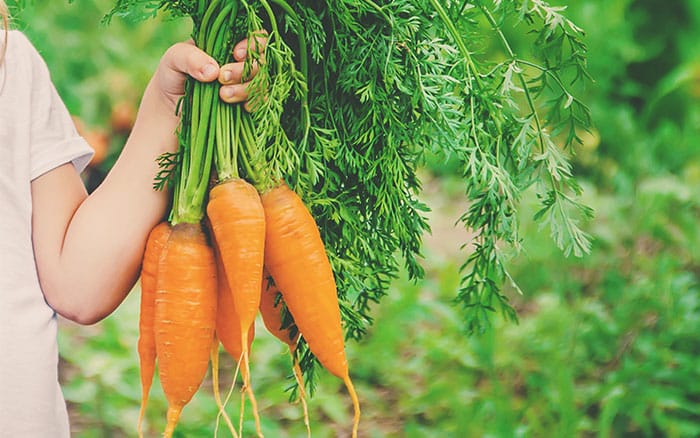ITV, along with Channel 4 and Sky, launch the 2020 campaign ‘Eat Them To Defeat Them’ encouraging children’s healthy living by eating more fresh vegetables.
Yesterday, on ITV1, I teamed up with James Martin on his Saturday Morning show to explain the power that vegetables have in boosting children’s health and wellbeing. So far, this campaign has encouraged 650,000 children to eat healthy veggies.
Vital veggies
Focusing on a different vegetable each week, they hope to encourage kids to put on their superhero capes and munch vegetables into submission, and in doing so, each vegetable releases powers for better health to children everywhere. So, let’s look at each of these vegetables and what goodness they offer.
- Carrots
Carrots are a health heavyweight, packing in a whole array of antioxidants and vitamin content. The most important punch it delivers is called beta-carotene, which converts to vitamin A once it’s eaten. This not only contributes to lung and brain health but protects eye health to help kids see in the dark.
Carrots are easy to grow, you can sow early carrot varieties from February onwards into deep, loose soil within a sunny location; they’ll even grow in pots and containers!

Ready to crop from July to September, blend into soups to deliver a nourishing and tasty dish for children or have as an excellent raw snack on car journeys.
2. Peas

Green peas are a powerhouse in the nutrition department—full of minerals like iron and B vitamins. This means that eating peas gives their body the nourishment it needs to keep transporting oxygen around the body to make you feel more energised.
They’re so versatile to cook with and early peas can be sown in an open, sunny location with good drainage from March. Peas will be ready to pick in just 11-13 weeks and are a great addition to the plate; from Sunday lunch to fish and chips.
They’re sweeter when they’re first picked as, with time, the sugars turn to starch—which is the normal pea taste.
3. Sweetcorn
Sweetcorn is full of vitamins and minerals, including marvellous magnesium. This is great for regulating muscle and nerve function, and even making their body’s DNA, meaning their body recovers faster.
You can get easy-to-grow varieties; sowing in late spring in a sunny and sheltered position. As sweetcorn is wind-pollinated, it’s best to plant in blocks rather than rows. They’ll be ready to harvest later summer and work great in tuna sandwiches or delicious with butter on the cob.

4. Broccoli

When it comes to vitamin vigour, K cannot be bested—and broccoli is chock-full of the stuff. Vitamin K can offer you benefits to your blood, looks after bone metabolism, and enhances blood function too, so it’s vital for healing wounds properly. One cup holds 116 per cent of your Recommended Daily Intake (RDI) of vitamin K!
You can plant out from May, allowing space between each plant, and they’ll be harvest-ready from July onwards.
Broccoli is so much more than just a side veg, blend the florets into smoothies, add into crunchy salads, or Sunday lunches!
5. Tomatoes
The red-coloured carotenoid ‘lycopene’ can be found in tomato fruit, and it can boost heart health, protect skin from sun damage, and even prevent illness through its antioxidant qualities.
To count as one of your kid’s five a day, it’s recommended that they eat one medium tomato or seven cherry tomatoes, and homegrown will give taste like no other. Sow seed from late March and later transfer to a ‘grow-bag’ when the first truss (flower buds) appears, it will produce fruit for harvest in July.

You can make your own tomato puree at home for pizza bases and pasta sauce, or the kids will really enjoy picking them fresh off the vine when they’re lovely and tangy.
6. Peppers

Peppers are powerful veg warriors, and so are the people who eat them! Red bell peppers can hold up to three times the amount of vitamin C than an orange, believe it or not. So, all this vitamin C goes towards maintaining a healthy immune system to fight off colds.
Sow seeds from May in containers, in grow bags, or open ground—they’ll be happy as long as they have a spot in the sun.
Each colour of pepper is the same vegetable at different stages of ripeness, turning from green to yellow, orange and then red. They’ll be ready to add into suppers from July – October to pop into stir-fries for a lovely crunch.
Superfruit n’ veg
For me, growing your own fruit and veg has always been at the heart of getting my own children into grow-your-own food and healthy diets, and now you know just how easy it is to tap into homegrown goodness to deliver these superpowers to children’s plates.
Tip:
Lawn mixes containing Dwarf Ryegrass species
provide a thicker turf that’s more resistant to
wear and tear and ideal for dog-friendly
gardens!
Happy gardening everyone!
Reader questions
Do I need to cut back my evergreen ornamental grass?

Evergreen grasses don’t need cutting back like deciduous ones do. With evergreens, really you just give it a bit of a tidy up and remove any of the dead or spent growth. This can look unsightly but also uses up plant’s energy. Trying combing gout loose foliage to leave only sturdy vegetation in place. Else, you can fully cut back damaged evergreen grasses in spring.
When should I start prepping soil for sowing seeds?

You can prepare your seed beds now. Remove all weeds and then cover over with sheets of black plastic. You can also use fleece, polythene or cloches and this will help to warm up the soil ready for sowing in the coming months. You may also want to rake lime into acidic soils to prepare them for alkaline-loving plants or work in a pre-seeding organic fertiliser to encourage healthy growth.

Leave A Comment